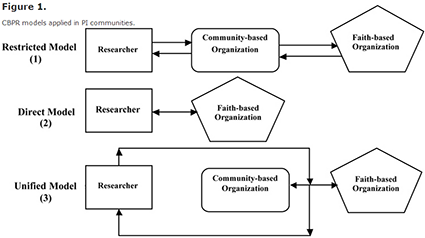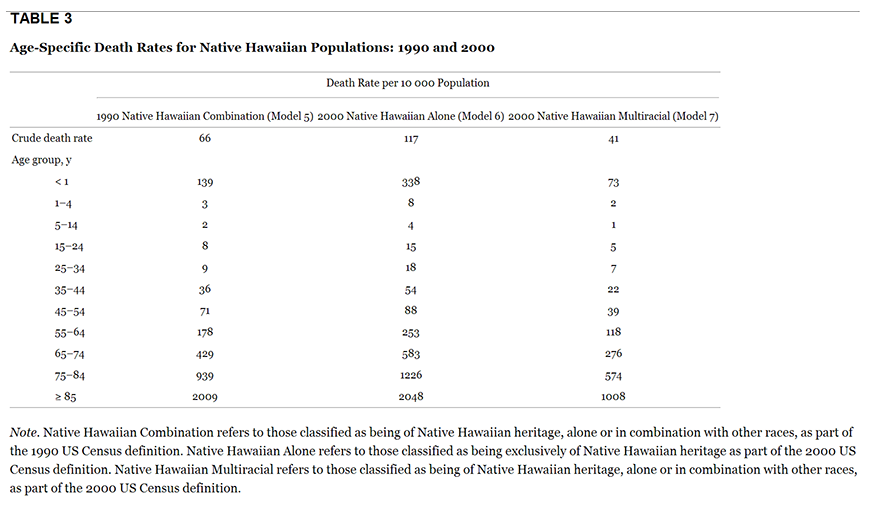Panapasa , S.V., Jackson J., Caldwell C., Heeringa S., McNally J., Williams D., Taumoepeau L., Young, L., Young S., Fa’asila S. (2012). Community-Based Participatory Research Approach to Evidence-Based Research: Lessons From the Pacific Islander American Health Study. Progress in Community Health Partnerships: Research, Education, and Action; 6(1): 53-64.
Reports on the Pacific Islander Health Study engagement with community-based organizations (CBOs) and faith-based organizations (FBOs) in Pacific Islander (PI) communities. The PIHS represents a model for overcoming challenges in data collection among small understudied populations. FBOs represent a valuable resource for community-based participatory research (CBPR) data collection and for effective interventions. The study methodology can be replicated for other racial/ethnic groups with high levels of religiosity combined with concentrated levels of residential clustering.
Panapasa, S.V., Crabbe, K., Kaholokula K. (2011). Efficacy of Federal Data: Revised OMB Standard for Native Hawaiian and Other Pacific Islanders Examined. API NEXUS: Special Issue on AA and PI Data, Research and Analysis; 9(1&2): 212-220.
This policy brief examines the status of federal data since the implementation of the 1997 Revised OMB 15 standards for the collection of race and ethnic data, identifies ongoing data limitations, and present recommendations to improve policy and interventions for Native Hawaiians and other Pacific Islanders (NHPI). While most federal agencies are taking appropriate steps to comply with the revised OMB standards, many are having less success reporting disaggregated information on NHPIs. This suggests that increased efforts to obtain robust samples of NHPIs warrants immediate attention in order for federal agencies to fully comply with the revised OMB standards.
Panapasa, S.V., Mau, M.K., Williams, D.R., and McNally, J.W. (2010). Mortality Patterns of Native Hawaiians across their Lifespan, 1990-2000. American Journal of Public Health; 100(11), 2304-2310.
We examined mortality patterns across the lifespan of Native Hawaiians and compared mortality disparities across races. We determined the age-specific and age-adjusted mortality rates of Native Hawaiians from 1990 to 2000 by using national census and vital registration data. Compared with Whites, Native Hawaiians and Blacks face similar challenges regarding infant and early-life mortality and increasing risks of mortality in mid-life and early old age. Our analyses document a need for renewed efforts to identify the determinants of ill health and commitment to address them.
Panapasa, S.V., Weed, J., and Atkinson, D. (2009). Health Data and Information Systems U.S. Territories and Freely Associated States Report. National Center for Health Statistics Center’s for Disease Control and Prevention and the US Department of Interior, Office of Insular Affairs.
The HDISR project was funded by the Department of the Interior, Office of Insular Affairs to address the need for a realistic assessment of the baseline information pertaining to the presence, quality, and potential value of existing data collection efforts that measure the health and well-being of the insular populations. The objectives were to identify and catalogue health datasets on populations of the US Territories and Compact of Free Association States, assess the effectiveness of existing data collection practices in insular areas, suggest ways to strengthen data collection to achieve timely and accurate data collection, and make recommendations to DOI about how best to improve the health data infrastructures in the US Territories.
Panapasa, S.V. (2009). Social, Demographic, and Cultural Characteristics of Pacific Islanders. Eds. Chau Trinh-Shevrin & Mariano Jose Rey. Health Issues in the Asian American Community. Jossey Bass Publishers. NYU School of Medicine Center for the Study of Asian American Health.
Learning Objectives
Describe the demographic, social, and economic characteristics of Native Hawaiian and Pacific Islander population in the fifty states. Discuss the differences between the Native Hawaiian and Pacific Islander population and its subgroups and the overall U.S. populations across select measures using the 2000 U.S. Census. Recognize the diversity and heterogeneity of the Native Hawaiian and Pacific Islander population.
Panapasa, S.V., Phua, V.C. and McNally, J.W. (2008). Economic Hardship among Elderly Pacific Islanders. AAPI Nexus: Special Issue on AAPI Aging. UCLA Asian American Studies Center.
Ensuring the economic well-being of the elderly represents a critical issue for social policy. The impacts of financial instability reach beyond individuals’ overall well-being and their family relationships. To date, little is known about the economic status of elderly Native Hawaiians Pacific Islanders (NHOPIs). This paper presents baseline information about the poverty status of NHOPI elders and how individual and household characteristics impact their economic well-being. Using bivariate and multivariate analyses, the results show that the risks of poverty vary markedly across different Pacific Islander subgroups, but all elders uniformly benefit from coresidence within an extended-family household.
Panapasa, S.V. (2007). Introduction on Social Support. Ciambrone, Desiree and Voon Chin Phua (Eds). Experiencing Aging: A Social Gerontology Reader. Deer Park, NY: Linus Publication Inc.
Social support is an important resource for people coping with myriad issues. This chapter reviews a sample of studies that illustrate the importance of social support systems in the lives of older adults. Through these examples, the reader is introduced to various conceptualizations and sources of social support.
Panapasa, S.V. (2007). In my Nana’s House: Grandparent Households in Fiji. Armstrong, J. and Flinn, J. (Eds) Grandparenting in Changing Pacific Communities. Pacific Studies; 30, 3/4.
This paper uses a combination of household census data and case material to examine change in grandparent status and role in Fiji in the context of development and the impacts of modernization and population aging. On one hand, there is more need and pressure for grandparents to be caregivers of grandchildren and sources of stability and continuity within family and home. On the other, there are the increased costs associated with greater longevity among the grandparent generation, such as care of a frail and dependent grandparent. Social exchange theory is used to compare these costs and benefits across five grandparent household types that vary according to composition and headship.
Panapasa, S.V. and Maharaj, J. (2003). Oral health of older adults in Fiji: 1985-1999. Pacific Health Dialog; 10:28-34.
This paper examines the oral health status of older adults in Fiji to determine the risks of dental disabilities. Using cross-sectional data collected in 1985 and 1999, logistic regression models are used to measure the effect of select demographic, socioeconomic and health variables on difficulty with chewing. While the general picture for the older persons is quite positive, the largest concern is the striking increase in poverty as a predictor for our dependent variable.
Panapasa, S.V. (2002). Disability Among Older Women and Men in Fiji: Concerns for the Future. Journal of Women & Aging; 14, 149-162.
This study examines the composition of elderly population at risk of disability and speculates the impact of disability on the quality of their lives and their longevity. Using census and survey data collected in Fiji, life table estimates of unimpaired life expectancy across time are presented forolder people and the potential costs of disability, in terms of productive years of life lost. From a planning perspective, the study discusses medical and support services that may be needed to support older individuals in Fiji. The study also describes policy implications of the findings, focusing on the older women, and considers the implications for older women of other developing countries.


